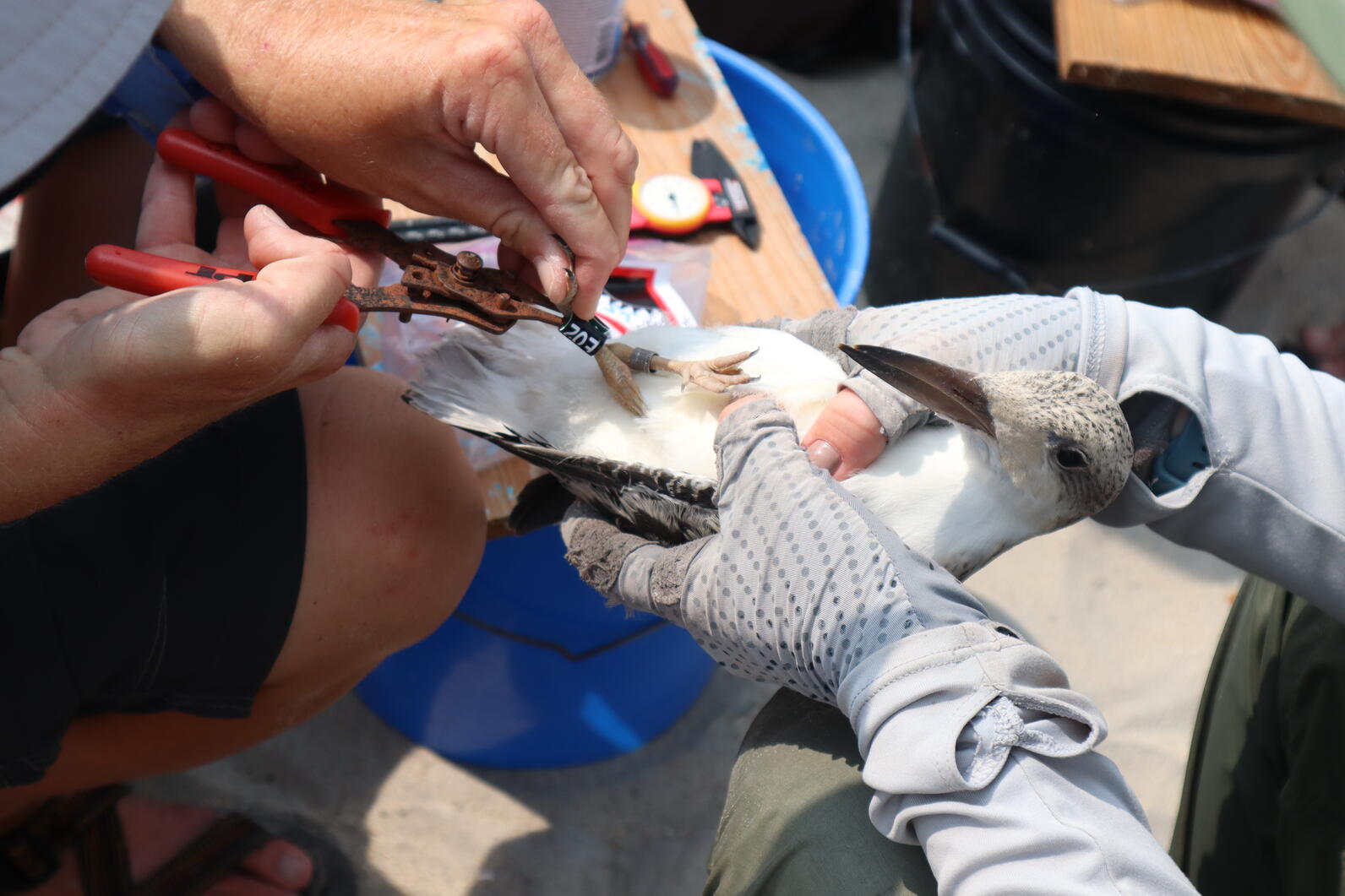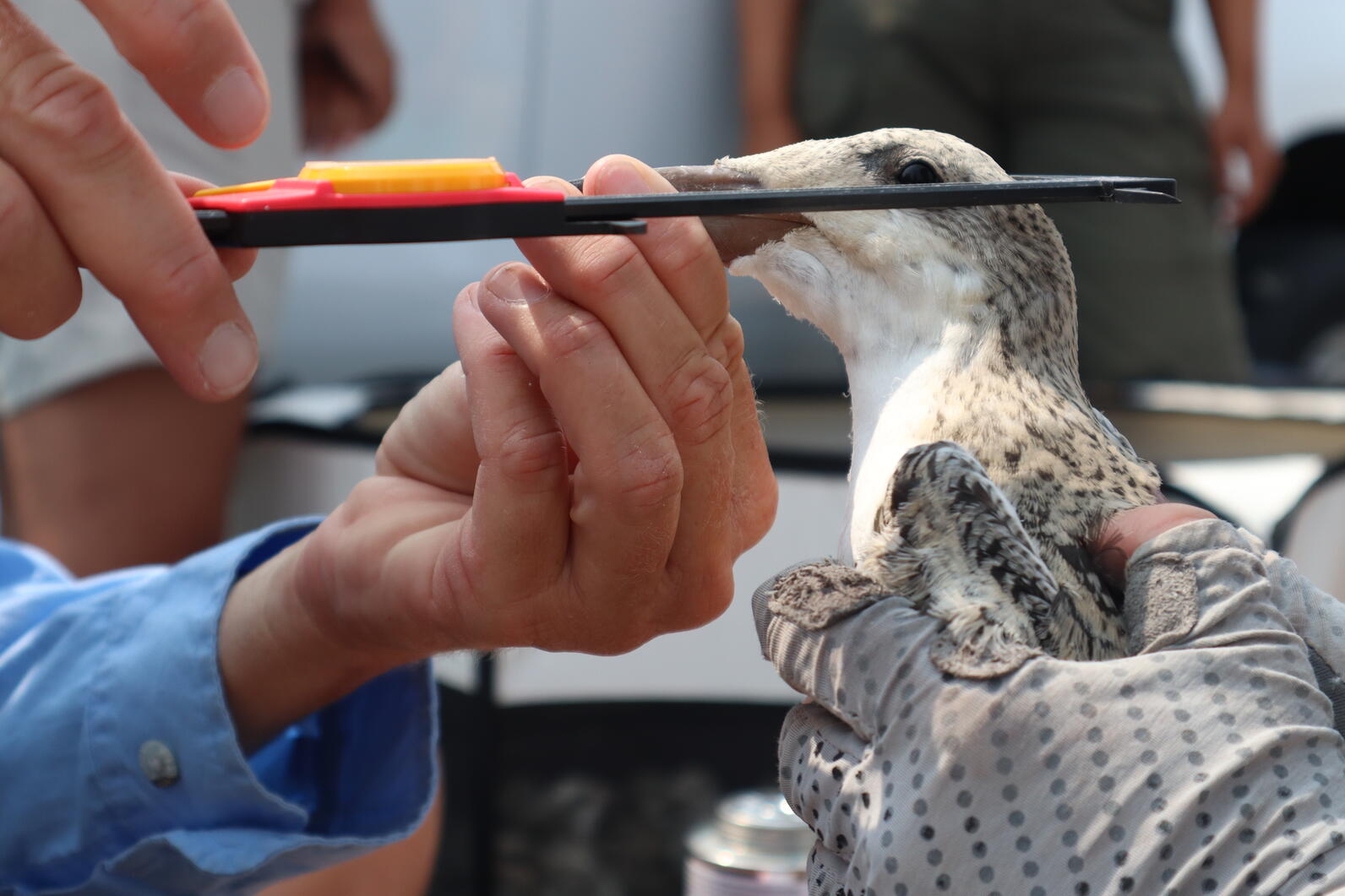Earlier this month, Audubon partnered with the National Park Service at Cape Lookout National Seashore to band one of this summer’s largest skimmer colonies on the North Carolina coast. This is the second year since 2015 that Cape Lookout has proven to be a stronghold for this late-nesting species.
Audubon’s partnership with the NPS took flight in 2021, when skimmers began nesting on a patch of open, bare sand on the south end of North Core Banks and near an inlet on South Core Banks. The team banded 100 of their chicks, but many more fledged. The goal of the project isn’t to band every chick, but to capture a sample that will represent that year’s cohort.
The partnership took a hiatus last year when the skimmers returned to the Seashore but were unable to raise any chicks due to depredation. Things are better in 2023. “We’ve counted about 300 nesting pairs here this year,” says Cape Lookout Resource Management Supervisor Jon Altman. “They first tried to nest on the north end of South Core Banks but failed due to predation by coyotes, so having this big of a colony here is great news and hopefully we can have a lot of successful fledglings.”
Within this colony, Coastal Biologist Lindsay Addison spotted 18 birds that she had banded in previous years, meaning that skimmers are successfully returning to the North Carolina coast and reproducing.
“This is why we band these birds,” adds Addison. “Bands help us know where they are going along the coast, estimate survival among different age classes, determine if they are reproducing, identify where they migrate, and much more.”
Despite a strong colony on Cape Lookout, survey data has not been positive for Black Skimmer populations across North Carolina. The statewide waterbird census, which takes place every three years, shows steady declines. In 2020, skimmer numbers were down 54% from the 2017 census, with only 323 nests at 6 sites across North Carolina in total. During the previous 10 years, skimmer pairs had averaged a little over 600 for the state. This year's numbers aren’t final, so their current status remains to be seen.

Skimmer Scramble
This summer, the first day of skimmer banding took place on a bright, clear day. Lovingly known as the “skimmer scramble,” banding Black Skimmers involves staff and volunteers carefully following after lively skimmer chicks who scatter when approached. Mesh drift fencing heads them off and they are scooped up in nets.
“It's a bit like what happens when you drop a glass bottle and the tiny, hard to see pieces go everywhere,” says Addison. “The skimmer chicks dart off in every direction and are hard to spot because they blend in extremely well with the sand.”
Once gathered, the chicks are given a metal band with a unique number combination and a black field-readable band with a unique letter- number combination, so they can be identified with binoculars or spotting scopes while they are wild and free.
The chicks are weighed after and their head and wings are measured as well. Once this process is complete, the chicks are taken back to their eagerly awaiting parents. In total, Audubon and our partners banded 51 skimmers on this trip, with over 450 banded on the North Carolina coast in the past five years.
“Because they don’t always nest synchronously, skimmers can be hard to count,” Addison says, “but the magnitude of the declines, which are mirrored in other states, is a big concern and the reason we started the banding program.”

Plagued by Flooding and Predation
Skimmer colonies up and down the coast from Wrightsville Beach to Pea Island National Wildlife Refuge face the same threats as other beach-nesting birds. Skimmers, however, seem to be particularly plagued by flooding from high tides and storms, as well as predation from coyotes.
They are usually the last beach-nesting species to begin laying eggs each summer, as they wait for other species to start nesting first. In this way, skimmers benefit from the colony defense of more aggressive species like Gull-billed Terns and Common Terns by nesting near, or in the case of Cape Lookout, among already established tern colonies.
Even with this added defense, with hurricane season upon us, this colony is one bad storm or high-tide event away from losing their nests. Coyotes are similarly dangerous in that they can clean out swaths of nests or even chicks in just a few trips.
This is why it is essential for people and their dogs to not compound these threats by venturing too close to roped off areas of the beach. When people or dogs are nearby, parents will leave the nest and are then unable to protect their eggs and small chicks from natural hazards.
Our coastal team monitors a network of sanctuaries from the Cape Fear River to Pamlico Sound, but partnerships such as the one at Cape Lookout National Seashore allow us to coordinate efforts across North Carolina. This helps us ensure coastal nesting waterbirds have safe places to hatch and raise their chicks and can continue to thrive in our state.
*All banding, marking, and sampling is being conducted under a federally authorized Bird Banding Permit issued by the U.S. Geological Survey’s Bird Banding Lab. Report band re-sightings here!







